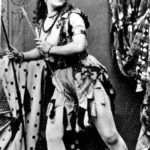Adah Isaacs Menken. Photo: American Jewish Historical Society.
She flew on fake horses above the stage, wore nude bodysuits so audiences would think she was naked, married four men (and divorced three)—and was surrounded by rumors of affairs with dozens of famous writers. Actress Adah Menken (1835-1868) was one of the first international celebrities, due more to her daring exploits and shrewd publicity than her acting talent. Multifaceted to the end, she was also a painter, a highly public poet and a committed Jew.
Born in New Orleans, Adah started out acting in small roles to earn money, but started getting real attention after playing the male lead in a stage version of Mazeppa, modeled on the poem by Lord Byron. At the play’s climax, Adah was tied to a dummy horse, naked but for a nude body sock and whirring above the audience.
The spectacle had the desired effect of shocking the audience, and it set off unprecedented hype. Menken suddenly found herself talked about in London and New York, and her image—thanks to the increasing use of photography—was plastered all over the two urban centers of the world.
Since Adah also wrote poetry, she gradually gained entry into literary circles. That turned out to generate even more publicity, mostly in the form of gossip about the nature of her relationships with writers, the other celebrities of the day. Rumors swirled about her closeness to the likes of Walt Whitman, Charles Dickens, Dante Gabriel Rosetti and the elderly Alexandre Dumas—fueled by photographs of Adah with the men.
Adah seemed to relish the controversy and attention she sparked, and in some ways even encouraged it by defying the social norms of the day: She cut her black hair short, openly smoked cigarettes and went through a series of husbands in the span of seven years.
Due to her own conflicting accounts of her early life, it is unknown if she was born Jewish or converted for her first—and only Jewish—husband, Alexander Isaacs Menken, but she appears to have been devoted to Judaism for the remainder of her life. She once explained to a reporter, “Through that pure and simple religion I have found greatest comfort and blessing.”
Indeed, Adah was a frequent poetic contributor to The Israelite, a Cincinnati weekly paper, refused to perform on the Jewish High Holidays and, on her deathbed at the age of 33, was attended to by a rabbi. Dying of tuberculosis at her peak, Adah still seemed to be content with the way her life had played out. In a note to a friend several hours before her death, Adah wrote:
I am lost to art and life. Yet, when all is said and done, have I not at my age tasted more of life than most women who live to be a hundred? It is fair, then, that I should go where old people go.
The AJHS at the Center for Jewish History holds a collection of personal objects and promotional materials related to Adah, including photographs, letters and playbills.


